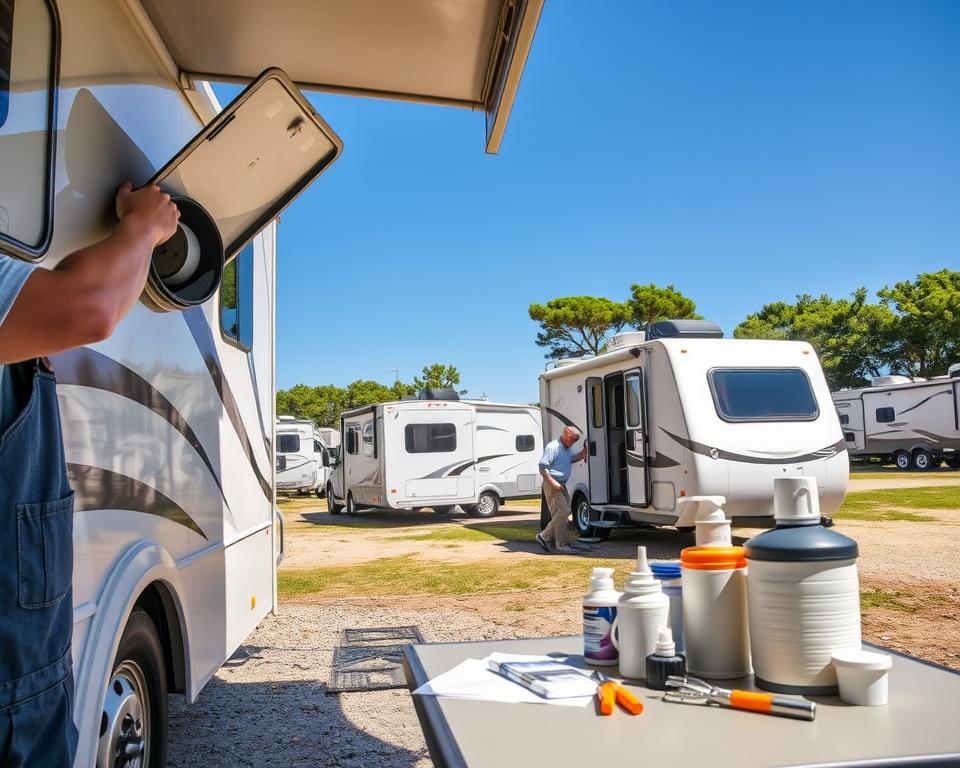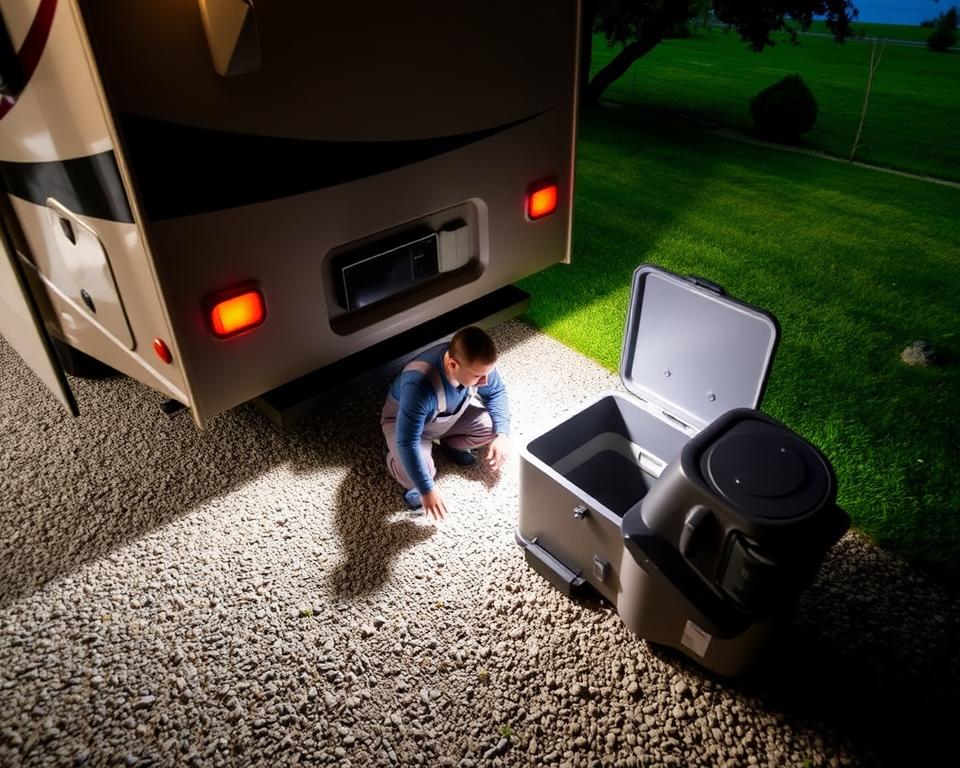Camper Waste Pump Manual: Optimized Dumping Approaches
Have you ever considered how key effective waste management is while camping in your RV? Countless campers notice waste handling dulls their excitement. The effort to find a suitable dumping station and the complications of black-water tank care can influence your camping experience. Yet, a trustworthy RV waste pump offers optimal operation for smooth waste disposal. This guide emphasizes the value of RV sewage pumps in upgrading disposal routines. It secures hygiene, upgrading your RV journey.
Key Takeaways
- Effective waste management is vital for RV owners.
- Dependable sewage pumps can improve dumping routines.
- Mobile sewage pumps increase comfort during RV adventures.
- Knowing sludge tank upkeep is crucial for RV sanitation.
- Optimized dumping methods enhance overall outdoor journeys.
Understanding RV Waste Management
Maintaining hygiene and comfort in your travels needs proper RV waste management. A well-designed system includes a solid waste reservoir for human waste. It also features additional hygiene modules. Knowing how these components work is essential for safe and hassle-free waste disposal.
Camper-generated waste is distinct from residential effluent. This point underscores the need of dedicated sewage handling. Trippers need to learn on caring for their sewage reservoir. Such effort wards off odors and clogs, which can ruin your trip.
Finding dumping stations is essential, especially in isolated campsites. While many RV parks provide proper facilities, they might not always be available. Thus, preparing in advance is important. This preparation can considerably boost your camping experience.
In summary, managing RV waste effectively requires knowing your RV’s waste system and planning for sanitation. Being knowledgeable guarantees a smoother trip in your RV.
RV Pump Explained
A camper sewage pump is essential for disposing sewage from recreational vehicles. The camper grinder unit chops solid waste into fine mixture. This enables easy pumping through a garden hose to a disposal site. It’s especially helpful when slope is insufficient.
Standard RV waste pumps and grinder units contrast in operation. Grinder units pulverize solids, providing added ease. This improves empties in remote areas.
All users need to grasp how an RV waste pump behaves. Using a grinder unit improves waste management, also facilitates removal in remote areas. Proper use keeps the disposal system efficient, uplifting your RV adventures.
Mechanics of a Macerator Pump
An RV macerator pump features premium cutting elements that pulverize waste into a uniform slurry, similar to a garbage grinder. This power is indispensable for disposal in RVs. By turning solids into liquid, the pump allows sewage to be transported across yards. It also helps in transporting uphill, preventing clog risks.
Each time the toilet is flushed, the grinder blades are triggered to start. This automatic activation ensures a hassle-free disposal. It simplifies the disposal process, especially when connecting to sewage lines. Thus, RV owners are guaranteed of a secure pumping setup.

Benefits of Using an RV Waste Pump
An RV waste pump offers substantial benefits in efficient waste disposal, revolutionizing waste management for RV enthusiasts. A major perk is the improvement in hygiene. This device optimizes disposal, significantly lowering contamination risks.
Owning a grinder unit means managing sewage with ease, even in remote areas. This gets rid of the need for traditional, bulky disposal methods. The ease it offers provides peace of mind while traveling. It grants quick hookups or portable dump stations, on-site or on the go.
Moreover, these pumps are engineered for odor control. Many come equipped with features aimed at suppressing odors. This creates a more hygienic environment inside your RV, making trips more enjoyable.
Their space-saving design means they don’t take up much room, preserving valuable space for other essentials. Opting for an RV waste pump is a wise decision for upgrading your camping lifestyle.
Applications of an RV Waste Pump
Macerator pump units are not exclusive to RVs. They are vital for proper sewage handling in various contexts. This includes boats, tiny homes, and even build zones. They meet diverse needs, adapting to situations and disposal requirements.
For those in off-grid spots, RV waste pumps are revolutionary. They make mobile waste disposal straightforward. Enthusiasts can then embrace camping, free from dump station hunts. It’s a must-have for anyone passionate about RV camping.
In the compact housing field, these pumps are essential. Room is scarce, and sanitation is key. RV waste pumps solve both, managing waste without taking up too much room. They fit seamlessly into tight quarters.
Project zones see a lot of waste. RV waste pumps deliver aid to this task. They prevent mess, and meet safety standards. Their strength in sludge handling makes them vital for construction projects.
Such adaptability underscores their value in effective waste management. They are key in multiple scenarios, from RVs and tiny homes to construction sites. Their trustworthiness in upgrading disposal is second to none.
Selecting the Ideal Camper Pump
Choosing the right RV waste pump involves several key considerations. Evaluating the pump’s footprint, robustness, and fit for your RV’s size is vital. It’s essential to pick a pump that can meet how often you’ll use it.
Crucial aspects to ponder are:
- Usage rate: Assess how often you’ll need the pump to clear sewage properly.
- Route type: Consider the types of routes you’ll encounter. Some pumps perform better on inclines.
- Setup convenience: Opt for models that are straightforward to install, so you can start using them without extra effort.
- Waste management requirements: Determine the waste consistency you’ll be pumping to ensure pump compatibility.
Take care in analyzing these elements. This guarantees you make a well-informed choice. Selecting the perfect RV waste pump will significantly boost your RV experience.
Popular RV Waste Pumps on the Market
Selecting a top RV waste pump can greatly upgrade your RV lifestyle. Leading models include the Flojet 18555-000A. They boast functions that satisfy different uses within the RV community.
The SeberFlo pump is praised for its rapid action and intuitive design. It features a robust capacity that rapidly empties tanks. Its consistency and compact design make it a popular choice for those valuing speed.
The Flojet 18555-000A is renowned among sewage shredders. It is constructed for versatility, tackling different waste disposal needs with ease. Its strong build and intuitive controls affirm its necessity for longevity and performance enthusiasts.
| Feature | SewerFlo Quick Release | Flojet 18555-000A |
|---|---|---|
| Capacity | 30 GPM | 13 GPM |
| Weight | 8 lbs | 6 lbs |
| Mobility | High | Medium |
| Durability | Moderate | High |
Reviews of these RV pumps underscore their unique strengths that drive selections. User-friendliness and efficiency are key, steering users in their selections. Whether it’s the Flojet, noting their differences provides you find the ideal waste pump.
How to Install and Care for Camper Pumps
Proper setup of your RV waste pump is key. It provides a reliable join to the RV’s waste system, avoiding spills and maintaining top function. First pick an strategic site near the waste tank. This shortens discharge tubing, improving flow. Mount it sturdily, per the manufacturer’s guidelines for flawless operation.
To install your RV waste pump effectively, follow these tips:
- Assemble required parts and tools.
- Before starting, cut the electrical supply and empty the waste tank.
- Mount the pump in an airy, service-friendly spot.
- Connect the outlet tube to the pump and run it to the disposal area.
- Ensure all connections are leak-free before powering up the pump.
Effective upkeep significantly lengthens your pump’s lifespan. Here are important servicing advice:
- Check connections and tubing every month.
- Use manufacturer-approved cleaners to avoid buildup.
- Run the pump periodically when not in use to keep gaskets supple.
- Keep the pump area clear of debris.
Should you encounter issues like reduced flow, try these troubleshooting steps:
- Inspect the discharge hose for clogs.
- Verify pump has power and fittings are tight.
- Refer to the guidebook for troubleshooting.
Other Options for Camper Waste Management
RV owners need to handle sewage properly for a pleasant trip. Traditional dump stations are often unavailable in off-grid areas. Thus, exploring alternative methods is essential. A mobile RV pumping service allows on-site tank emptying, saving you time.
Other options include dry toilets and portable waste containers. Composting toilets require little moisture and produce fertilizer. Portable containers offer simple waste hauling as needed.
Choosing appropriately depends on personal preference. By evaluating these alternatives, RVers can ensure cleanliness while exploring.
Conclusion
Efficient RV waste management is vital for a tidy living space on the move. We’ve covered various waste pumps, their functions, and advantages. A quality pump enhances travel by ensuring swift disposal.
Choosing a pump from All in Sanitation streamlines dumping and boosts enjoyment. With suitable tools, RVers can travel stress-free, without dumping hassles, ensuring a better experience for all.
Keeping your RV clean underscores the need for efficient disposal, enhancing travel experiences and ensuring a safe, enjoyable environment.


